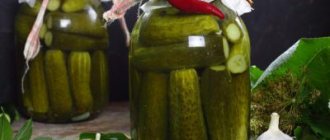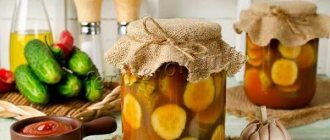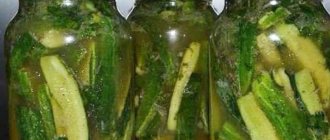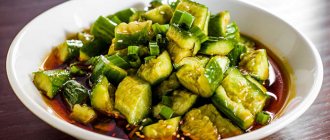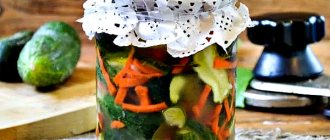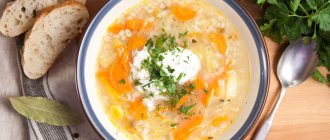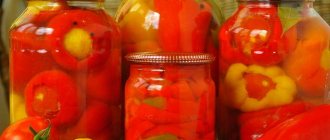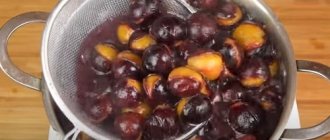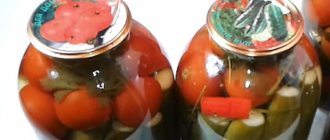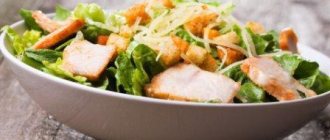Pickles have become popular recently. After all, such a preparation serves, if not the basis, then one of the ingredients of any snack, for example, a salad or a hamburger. A jar of such preservation is especially helpful when there are guests at the house and you want to quickly prepare something original and tasty. Today we will prepare these delicious cucumber pickles for the winter with apple cider vinegar for sandwiches, the recipe with photo is attached below. It should be noted that cucumbers prepared in this way have simply amazing taste and color. Indeed, in addition to the basic bouquet of spices, turmeric seasoning is added to the marinade. Quite an original solution, but as culinary practice shows, it is quite successful. Check out this one too. The technology for preparing pickles is, in principle, classic, nothing new: pickled cucumbers with onions must be boiled in a unique marinade, quickly transfer the mixture into jars and roll up. So the process itself is certainly not long, but pickling the cucumbers takes place within 3-4 hours.
- cucumbers (ground) - 1 kg., - onions - 2 pcs., - vinegar (apple) - 2 cups, - sugar - 1.8 cups, - salt, medium grind - 3 tbsp., - turmeric - 0.5 tsp, - pepper (black peas) - 0.5 tsp.
Recipe with photos step by step:
Finely chop the peeled onion into beautiful, neat rings. Wipe the washed cucumbers dry and cut into rings, about 0.5 cm thick. Mix the onions with cucumbers and salt, place a plate on the vegetable mass, and a weight on it and leave the structure in this form for 3-4 hours. We wash the cucumbers and onions under running water and place them in a colander. Pour apple cider vinegar into a saucepan and add all the spices. When the marinade starts to boil, pour it over the cucumbers. As soon as we bring the mass to a boil, immediately put it in sterilized jars and seal it hermetically. I bring to your attention recipes for very tasty
Are you still going to make blanks? Then this post is for you. Today’s recipe is an assortment of vegetables for the winter or pickled pickles, and we will have not one, but two recipes: to choose from (I didn’t choose, but made both, since I liked them in my own way).
“I make pickled pickles,” my friend said and showed me beautiful jars with assorted vegetables for the winter. These jars contained everything: in addition to tomatoes and cucumbers, there were even pieces of apple and onions with garlic.
When I asked her to copy the recipe, she handed me a clipping from an old newspaper. “This is analogous to the English word “pickles” - pickles,” I was surprised that the word was not translated. But it turned out that everything was correct there, and there is such a word in the Russian language. And that means it’s an assortment of small vegetables. This tradition of pickles is characteristic of English cuisine, where it once came from India. In Europe, pickles are used more often as side dishes, and in the USA - as a cold appetizer for strong drinks. Salty under strong, so to speak.
The pickle recipe I got is tailored to our tastes. English pickles have a lot of vinegar and are spicy for our taste. And here is the recipe for our preferences.
Recipe “Marinated pickles”
For this vegetable platter you will need, if possible, small vegetables: it’s good if your cucumbers are like gherkins and your tomatoes are like cherry tomatoes. You will also need the smallest zucchini and tiny onions and small, small carrots. I tried to collect exactly these, but not everything worked out: I couldn’t find gherkins, and we don’t sell carrots in this form (tiny ones).
The layout is given for 5 liter jars and the vegetables are laid out in layers so that one color alternates with another, and the jars themselves delight the eye with their variety of colors. And when I made the recipe step by step, as recommended, I still had a lot of vegetables left, and for them I took two more jars, this time larger, and repeated the recipe again. And what can I tell you: with larger jars the layers are clearer and everything fits.
Assorted vegetables for the winter - ingredients
(for 5 liter cans)
- 1-2 Antonovka apples
- 20 small cucumbers
- 20-25 small tomatoes
- 0.5 heads of cauliflower
- 3-4 regular carrots or 20 small ones
- 2 youngest zucchini
- 25 small onions
- 2.5 heads of garlic
- 4-5 bell peppers
- 5 stalks of celery
- Stems of dill and parsley
In each jar put:
- 1 bay leaf
- 1 clove bud
- 5 black peppercorns
Marinade for 5 liter jars:
- 2 liters of water
- 0.5 cups salt (100 g)
- 2/3 cup sugar (120 g)
- 1 cup vinegar (6%)
Pickles for the winter - preparation
The longest thing in this story is the preparatory process. So, all the vegetables need to be washed. Peel the carrots and cut into small pieces. Leave the washed zucchini with the skin and also cut into small pieces. Separate the cauliflower into small florets. Peel the skins of the onion and garlic too. I had these small onions, and there was a lot of fuss with them. But I just wanted there to be just small onions. My friend takes regular onions and cuts them into rings - that’s also good. So, after the first stage of preparation, all the components looked like this.
While they are “dipping” in boiling water, trim the edges of the cucumbers.
Yes, the jars need to be sterilized and placed on a clean towel.
And you can do greens. From dill and parsley you need to take only the stems. Wash them and cut them into 2-3 cm pieces. We will also need celery stalks with leaves. Wash them and don’t need to cut them.
Distribute celery and dill-parsley stalks into the bottom of each jar.
And now you can fill the jars. So, our sequence in each bank is as follows:
- — we start with a few pieces of Antonovka,
- - 4 cucumbers,
- - 4 tomatoes,
- - a handful of cauliflower florets,
- - a handful of carrot pieces,
- - a few pieces of zucchini,
- - 5 small onions (or a few pieces of chopped rings)
- - 5 cloves of garlic
- - strips of bell pepper (I took yellow and red)
Then put in each jar:
- - 1 bay leaf,
- - 1 bud of cloves,
- - 5 peppercorns
And prepare the marinade: boil all the ingredients except vinegar, and then, at the end, add vinegar and turn off the heat.
Pour hot marinade over assorted vegetables in jars, cover with lids and place in pans with lids for sterilization. Sterilize liter jars for 12 minutes (that is, 12 minutes after the water boils in the pan).
And at the end, roll up the jars, turn them over, cover them for a day, and then store them at room temperature. And after two weeks you can already taste it.
The recipe that I used to make this assortment of vegetables says that to improve the taste, you can “force” cool the jars. That is, after your jars have been sitting “under the blanket” for 15 minutes, you need to take them out, put them in a basin with warm water, and then gradually replace the water with cold water, then put them under running water until the jars have completely cooled down. I didn't suffer like that. But the idea is good, anyone interested can try it. You just need a lot of water (the recipe says to cool the jars for more than an hour). Who has meters is not at all interesting.
And I wrote that when I started putting everything in liter jars, I had a lot of vegetables left. I also had to use 3-liter and 1.5-liter cans. And cook the marinade again. These two jars required the same amount of marinade as the 5 liter jars.
This is what they look like the next day.
And one more recipe
INGREDIENTS
Garlic 8 cloves Dill 1 Pinch Bay leaf 2 Pieces Peppercorns 1 Teaspoon Dill seeds 1 Teaspoon Coriander seeds 1 Teaspoon Celery seeds 1 Teaspoon Fennel seeds 1 Teaspoon Chili flakes 1 Pinch Cucumbers 500 Grams Water 4 Glasses Vinegar 0 .5 glasses Salt 2 Teaspoons Sugar 0.5 Teaspoons
Year-round greenhouse: how to make it yourself, what you can grow in it, photos, videos - greenhouse tips
1.To prevent the garlic from darkening during the pickling process, peel it and place it in a saucepan with water. Bring to a boil and cook for 1 minute. Then drain the water immediately.
2. Prepare clean jars in which the pickles will be pickled. Place spices, blanched garlic and washed dill on the bottom.
3. Wash the cucumbers, dry them, cut off the ends on both sides. Place cucumbers in jars.
4. Now you can make the marinade. Bring water to a boil, adding salt and sugar first. Let it simmer for 1-2 minutes and then add vinegar. After 30 seconds, you can remove the marinade from the heat and pour it into jars.
5. Cool the cucumbers, cover with lids and put in the refrigerator. Fast, simple, and you will definitely be satisfied with the result. Store the preparation in the refrigerator.
m.povar.ru
Pickles are vegetables marinated in vinegar and spices. We suggest making pickles from cucumbers, tomatoes, cauliflower, onions and zucchini.
Sort vegetables and herbs, peel and rinse in running water.
Chop the carrots and zucchini, divide the cauliflower into inflorescences and place in a colander in boiling water for 3-4 minutes (blanch). Cut all the greens into 2-3 cm pieces.
Place vegetables tightly in jars. To do this, place a currant sprig with a leaf, a dry dill inflorescence, a handful of chopped herbs and a piece of apple on the bottom. Then five cucumbers, four tomatoes, cauliflower, pieces of carrots and zucchini, onions, cloves of garlic, strips of sweet pepper. Place the stalks of celery and dill in the jar as tightly as possible, almost to the very neck. Place a currant leaf with a sprig on top, a handful of chopped herbs, a dill inflorescence, 1 bay leaf, cloves, 3 peppercorns. Pour marinade over pickles. A 1-liter jar will require approximately 0.35 liters of marinade.
Marinade for pickles: boil water with sugar and salt, strain through cheesecloth. Boil again and add vinegar and spices before removing from heat.
Sterilize filled jars for 12-15 minutes from the moment of boiling, then roll up.
You can cook pickles without sterilizing the jars and without rolling the lids on your heads. Use the same recipe. Pour the pickles with a stronger marinade (1.5 cups of vinegar and 1 cup of salt); cabbage, carrots and zucchini need to be blanched longer (8-10 minutes, other vegetables - 3-5 minutes). Place the pickles in the refrigerator. After two weeks, the vegetables will be ready to eat.
www.russianfood.com
Assorted vegetables for the winter
This vegetable mix is good for many vegetables from the garden. It is different in its composition, but promises to be no less tasty. The layout is for a three-liter jar, which is very convenient. I wouldn’t recommend doing it in smaller jars: a little of everything and the jar is full.
Well, shall we get started?
Ingredients
(for a 3 liter jar)
- 3-4 carrots
- 0.5 heads of cabbage
- 1 small zucchini
- 1-2 bell peppers
- 1 large onion or 5-7 small ones
- 3-4 cloves of garlic
- 2-3 small beets
- 10-20 green beans (I didn't have any)
For the marinade (per 5 liters of water):
- 300 sugar
- 150 g salt
- 450 g vinegar
Assorted vegetables for the winter - preparation
Wash all vegetables.
Peel the carrots and beets. We free the pepper from seeds, onions and garlic from the husks.
Cut the carrots lengthwise into four pieces and place in the bottom of a sterilized jar.
Then - pieces of zucchini and bell peppers, cut into pieces as you like.
Then - onion rings or whole heads, if they are small, and garlic cloves.
And on top there are tiny beets. If you don’t have a small one, you can cut one large one into four parts.
The recipe also calls for green beans, but this is not the season, so I don’t have them in the jar.
When the jar is laid, you need to make the marinade. To do this, boil all the ingredients without vinegar, add vinegar at the end. Pour marinade over vegetables in a jar and sterilize for 30 minutes.
After sterilizing this assortment, roll up the jars, turn them over, and, as usual. Keep it “under the blanket” for a day.
On the second day, the beets colored everything like this. I think it’s prettier this way: I love it when the cabbage turns out with a beetroot tint. And now, traditionally, I took a photo of my jar on the balcony. I have a lot of Antonovkas there now, so they got into the frame.
The appetizer promises to be spicy.
And now, for those who are interested, (it’s already ready a day before).
Delicious preparations to you!
And in order not to miss a new interesting recipe, subscribe to the blog updates by email.
Cucumber pickles, prepared for the winter,
- This is a famous prepared snack of American cuisine, which can be served as an independent snack, used in salads, and also for sandwiches and sandwiches. The pickles turn out very tasty, sweet and sour, and have a beautiful golden color. From this quantity of products you will get 1 half-liter and one 250-gram jar of pickles.
"Moravian gherkin F1"
This is another mid-early, bee-pollinated variety. These cucumbers can only be grown in open ground. The fruits of the “Moravian gherkin” are spindle-shaped and can reach 8-10 cm in length. They begin to ripen approximately on the 45th day after planting.
Experienced gardeners recommend collecting greens of this hybrid for canning at intervals of a maximum of 2-3 days. It is even allowed to pick them for pickling daily. Gardeners include crop stability and disease resistance as the advantages of this hybrid. “Moravian gherkin F1” differs from many other varieties of pickles and gherkins in its ease of care. Growing this hybrid on the site will not be difficult.
Moravian gherkin F1 cucumbers, among other things, contain substances that are beneficial to human health. The potassium, calcium and phosphorus contained in their pulp normalize the functioning of the cardiovascular system. The iodine contained in fruits has a beneficial effect on the thyroid gland.
Cooking steps
Cut the cucumbers into slices about 0.5 cm thick.
Add peeled onions, cut into thin rings or half rings, to the cucumbers, add salt, mix well, put pressure on top of the cucumbers and leave for 3-4 hours.
Pour apple cider vinegar into the pan, add sugar, allspice, grain mustard and turmeric, stir. Bring the marinade to a boil, cook until the sugar dissolves.
Place the pickles in sterilized jars.
Roll up the cucumber pickles prepared for the winter with boiled lids and turn the jars over.
Next, wrap the jars until they cool completely. You can store this product at room temperature. Extraordinarily tasty cucumber pickles will perfectly diversify your winter menu.
Enjoy your meal!
Vegetables
Description
Pickled cucumbers for the winter
- This is a tasty and savory snack that will attract attention with its appearance and aroma. Making this salad with your own hands at home is very simple and quick. It will definitely appeal to all housewives who love and welcome the preparation of pickles without sterilization.
Cucumbers contain many useful substances that have a beneficial effect on the human body. Eating them has a good effect on the motility of the digestive system, improves metabolism and speeds up metabolism, removing toxins. This, in turn, helps strengthen the immune system and helps fight viruses and bacteria, as well as their waste products, which is especially important in winter.
In folk medicine, cucumber juice was used as an antipyretic. Eating cucumbers is also beneficial for the nervous system. A large amount of potassium helps combat the formation of kidney stones, and iodine contributes to the proper functioning of the pancreas. It is for these qualities, as well as for their low calorie content, that cucumbers are valued. They are a favorite vegetable among people who lead a healthy lifestyle and adhere to the principles of a healthy diet.
This preparation is perfectly preserved throughout the winter; the cucumbers in it remain dense and crunchy, and when eaten they melt in the mouth. Your guests and household members will definitely be interested in the taste of these young pickled cucumbers, because it is not at all the same as everyone else’s. Due to their variety and size, the pickles have a sweet pulp, in which the seeds are completely imperceptible. Try it yourself and you will understand the difference! And we are waiting for your feedback.
The most inexperienced housewife in cooking can cope with this task, and she will be helped in this by a detailed description of all actions with step-by-step photographs that clearly display the entire cooking process in detail.
Steps
- To prepare this salad, select the most beautiful and smooth cucumbers, the length of which does not exceed seven centimeters. Rinse them in running water and wipe dry. You will also need two onions, the size of which should not be larger than a large chicken egg. Peel the onions. Measure out the indicated amount of salt, granulated sugar, vinegar and vegetable oil
.
Cut the cucumbers into circles, the thickness of which is five millimeters, as shown in the photo.
Cut the onions into two parts each, and then into half rings.
Before chopping, put the product in water to remove caustic esters that irritate the mucous membranes of the eyes and cause lacrimation, which is especially important when using young onions.
Mix cucumbers and onions in a deep bowl.
Now add salt to the salad and mix well so that the salt crystals dissolve. The cucumbers will begin to release juice.
Cover the salad as shown in the picture. Absolutely any heavy and clean object that does not absorb water can act as a load. Leave the structure for three hours, placing the bowl of salad in a cool place. Meanwhile, prepare jars and lids. Wash everything in warm water with baking soda and rinse until shiny. Then steam the jars or microwave them at full power for at least five minutes each, and boil the lids in boiling water for about two minutes.
Tin lids for machine sealing have rubber seals, so be sure to remove them before immersing them in boiling water. Return the rings to their original place only after the metal has completely cooled.
After the specified time has passed, strain off the salted juice, discarding the cucumber-onion mixture in a colander, as shown in the photo. After the excess brine has drained, rinse the assortment with running water.
Meanwhile, make the marinade: mix granulated sugar with natural apple or wine vinegar and vegetable oil. After this, add turmeric and add black peppercorns to the mixture, and, if desired, pieces of chopped bay leaf. To prepare the marinade, choose a deep bowl with a thick bottom.
.
Heat the mixture over low heat or in a water bath until it boils. The marinade is considered ready as soon as the sugar is completely dissolved in it.
Now add the pickles and onions to the sauce and heat the salad until it boils.
Transfer the finished product into sterile jars. Place the assortment tightly, carefully pressing down the salad with a spoon. When all the cucumbers are laid out, divide the marinade into jars in equal parts
.
Roll up the workpiece and turn the cans upside down, as shown in the photo. A delicious and sweet salad for the winter from small cucumbers is ready! Leave the pickles to cool in this position on the table. There is no need to wrap the workpiece.
Store the prepared cucumbers in a cold and well-ventilated area for a calendar year, and place the uncorked jar of salad in the refrigerator, covering it with a nylon lid.
You can take the first sample from pickles prepared for the winter only after a month.
Serve them simply by pouring them from the jar into a salad bowl.
Bon appetit!
If you like to prepare all kinds of hot sandwiches, sandwiches, hamburgers, various interesting salads (without mayonnaise), it would be nice to have a stock of spicy, sweet and sour pickles.
Many people mistakenly assume that the word “piculi” means a variety of cucumbers. It's not like that at all. Initially, pickles were any vegetables pickled at the greens stage (eggplant ovaries, small garlic or onion heads, miniature ears of corn). In English, the word “piculi” literally translates as “pickled.” Over time, it began to be used more and more often in relation to small cucumbers collected at two days of age, while they were not yet formed. Such pickles have a special cucumber flavor, piquant, unique to them.
It is most convenient to seal pickled cucumbers for the winter in a small container. A kilogram of vegetables yields 4 jars of 0.33 liters each. It’s unlikely that you’ll be able to eat them just like that with potatoes, they’re too vigorous. But for sandwiches or pizza, this preparation is ideal.
Taste Info Cucumbers for the winter
Step-by-step recipe with photos
To prepare pickled pickles, you need to follow the recipe exactly: from preliminary preparation of plant ingredients for canning to preparing the marinade strictly according to the recipe.
The stalks are trimmed, the cauliflower is cleaned and taken apart. Carrots and cauliflower need pre-heating to soften. Canning jars must be sterilized with hot steam or in the oven.
Preparing vegetables
If the housewife was unable to buy all the ingredients specified in the recipe or vegetables of the required size, no worries. In pickling pickles, the most important thing is the marinade recipe, and the ingredients can be changed at your discretion (put more of some, don’t put something at all).
Root vegetables that are larger in size than necessary can be cut into rings or pieces. The main thing is that all components (cut and whole) are approximately the same size. The prepared pickles are laid out in separate containers, from which they will then be collected (cucumbers separately, onions separately).
Let's start with the preliminary preparations:
- all vegetables are washed well in several waters;
- root vegetables are peeled;
- the onion is peeled;
- tomatoes are picked from the tomato brush to which they are attached;
- carrots and cauliflower are boiled a little;
- cucumbers have their “butts” cut off on both sides.
Some vegetables and root vegetables, due to their density and hardness, require additional heating in boiling water. This cooking technique is called blanching. In our case, products such as cauliflower and carrots need blanching.
Before blanching, cauliflower must be disassembled into small inflorescences. If the carrot is slightly larger than needed, then it needs to be cut lengthwise into four parts (or into thick rings). Blanch cauliflower and carrots separately in boiling water.
To do this, they are immersed in boiling water for 5 minutes, after which they are caught from the boiling water using a kitchen colander. When further laying out the pickles in layers in jars, these partially boiled cauliflower and carrots are also used. Place all the ingredients into 5 piles of approximately the same size. This is done so that the hostess does not forget to put anything in the jar.
Stuffing in jars
Vegetables are placed in layers in jars washed with soda. When laying layers, it is advisable to make them contrasting. For example, after a layer of white cauliflower inflorescences, you should lay a layer of red cherry tomatoes or bright orange carrots, the next layer is laid of light vegetables (onions, garlic or zucchini).
Such contrasting layers are laid to the very top of the container - this will give an elegant look to the preservation.
Pour boiling water
When the containers are filled to the top, they are filled with boiling water. The jars are filled with boiling water very carefully, 1/3 of the entire container is immediately poured, after 30 seconds the rest of the boiling water is slowly added. These precautions are necessary to ensure that the glass does not crack due to sudden temperature changes. The hot liquid should reach the neck of the container.
Important!
Particular attention should be paid to the fact that after any type of sterilization or heating with boiling water, the surface of the glass will be red-hot, and in order not to get burned, the housewife should use oven mitts or towels when working with them.
Warming up
After this, the jars are covered with a metal lid for preservation and placed in the oven for 15 minutes. The oven must be preheated at +100 °C. This is necessary so that all the ingredients are thoroughly heated.
After heating is complete, pour the hot water from the jars into a saucepan. Place jars of heated vegetables in the oven while preparing the marinade or wrap them in a warm towel. This will prevent them from cooling down.
Cooking the marinade
When the vegetables are placed in jars, all that remains is to properly cook the marinade. Using a liter container, measure the hot water drained from the cans. We set its quantity, and taking this data into account, prepare the marinade.
Marinade recipe for pickled pickles (per 1 liter of water):
- add 40 g of salt and 40 g of sugar to the water, 10 pcs. black peppercorns and 20 coriander grains;
- stirring, bring the contents of the pan to a boil and simmer over low heat for two minutes until the sugar and salt are completely dissolved;
- pour 50 g of vinegar (9%) into the slightly boiling marinade and tightly close the saucepan with a lid (you can use either apple or wine vinegar);
- quickly bring the marinade with vinegar to a boil (so that the vinegar does not evaporate).
The marinade is ready.
It is poured into containers filled with vegetables, which are sterilized before rolling. Did you know?
According to doctors, when preparing preserves, it is advisable to use natural apple cider vinegar, wild apple cider vinegar, or juice. It is these components that are not only beneficial for the human body, but also soften the taste of canned foods. For 1 liter of brine or marinade, take 200 ml of cranberry juice or half a glass of wild yellow cherry plum berries. Doctors also approve of the use of acid (0.5 tsp per 1 liter of water) in canning.
Fill and sterilize
Let's move on to the final stage:
Filled with herbs, spices and vegetables, the jars filled with hot marinade are placed on a baking sheet in the oven. The neck of each jar is covered with a metal lid for preservation (without rolling up), this will prevent the marinade from boiling away during the sterilization process.
The baking sheet is carefully placed in the oven to sterilize the pickles. The oven timer sets the temperature to +200 °C. The jars need to be sterilized until a chain of bubbles begins to rise from the bottom to the neck. This is a sign that the marinade is starting to boil in the jar. After which the pickles are sterilized for another 20 minutes at the same temperature. After 20 minutes, turn off the oven and take out the jars of pickles.

